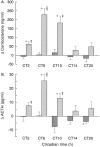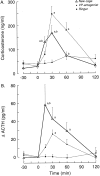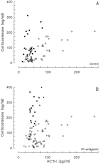A diurnal rhythm of stimulatory input to the hypothalamo-pituitary-adrenal system as revealed by timed intrahypothalamic administration of the vasopressin V1 antagonist
- PMID: 8757267
- PMCID: PMC6578885
- DOI: 10.1523/JNEUROSCI.16-17-05555.1996
A diurnal rhythm of stimulatory input to the hypothalamo-pituitary-adrenal system as revealed by timed intrahypothalamic administration of the vasopressin V1 antagonist
Abstract
The mammalian suprachiasmatic nuclei (SCN) contain an endogenous pacemaker that generates daily rhythms in behavior and secretion of hormones. We hypothesized that the SCN imposes its circadian rhythm on the rest of the brain via a rhythmic release of its transmitters in its target areas. Previously, we demonstrated a pronounced inhibitory effect of vasopressin (VP), released from SCN terminals in the dorsomedial hypothalamus, on the release of the adrenal hormone corticosterone. In the present study, microdialysis-mediated intracerebral administration of the VP V1-receptor antagonist was used to pursue the study of the mechanisms underlying the circadian control of basal corticosterone release. Using timed administrations of the VP antagonist divided equally over the day/night cycle, we were able to uncover the existence of an additional stimulatory input from the SCN to the hypothalamopituitary-adrenal (HPA) axis. Peak activity of this stimulatory SCN input takes place during the second half of the light period, after the daily peak of VP secretion, with a delay of approximately 4-6 hr. In all likelihood, the inhibitory and stimulatory circadian input via separate mechanisms affects corticosterone release. Together, these two opposing circadian control mechanisms of the HPA axis enable a precise timing of the circadian peak in corticosterone release.
Figures









References
-
- Abe K, Kroning J, Greer MA, Critchlow V. Effects of destruction of the suprachiasmatic nuclei on the circadian rhythms in plasma corticosterone, body temperature, feeding and plasma thyrotropin. Neuroendocrinology. 1979;29:119–131. - PubMed
-
- Akana SF, Cascio CS, Du J-Z, Levin N, Dallman MF. Reset of feedback in the adrenocortical system: an apparent shift in sensitivity of adrenocorticotropin to inhibition by corticosterone between morning and evening. Endocrinology. 1986;119:2325–2332. - PubMed
-
- Alexander LD, Sander LD. Vasoactive intestinal peptide stimulates ACTH and corticosterone release after injection into the PVN. Regul Pept. 1994;51:221–227. - PubMed
-
- Bagdy G, Chrousos GP, Calogero AE. Circadian patterns of plasma immunoreactive corticotropin, beta-endorphin, corticosterone and prolactin after immunoneutralization of corticotropin-releasing hormone. Neuroendocrinology. 1991;53:573–578. - PubMed
-
- Bernardini R, Chiarenza A, Kamilaris TC, Renaud N, Lempereur L, Demitrack M, Gold PW, Chrousos GP. In vivo and in vitro effects of arginine-vasopressin receptor antagonists on the hypothalamic-pituitary-adrenal axis in the rat. Neuroendocrinology. 1994;60:503–508. - PubMed
Publication types
MeSH terms
Substances
LinkOut - more resources
Full Text Sources
Other Literature Sources
